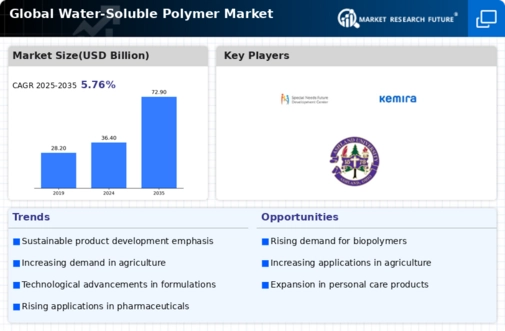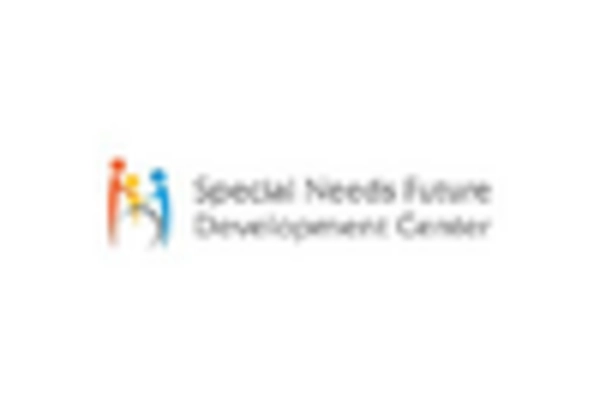Market Analysis
Global Water-Soluble Polymer Market (Global, 2023)
Introduction
Water-soluble polymers are experiencing a transformation in the water-soluble polymers market, driven by the increasing demand for sustainable and environment-friendly materials in various industries. Water-soluble polymers, which are known for their versatility and functionality, are used in agrochemicals, pharmaceuticals, food and beverage, and personal care products. However, as the importance of water conservation increases, manufacturers are focusing on developing water-soluble polymers that not only meet the performance standards but also comply with the regulations and consumer preferences for biodegradable and non-toxic solutions. The market is highly competitive, with many companies, from well-established chemical companies to emerging start-ups, competing to win market share through technological advancements and strategic alliances. The dynamic market environment offers both opportunities and challenges to companies in terms of managing supply chains, acquiring raw materials, and developing new products to stay ahead in the competition.
PESTLE Analysis
- Political
- The international water-soluble polymer market is affected by a number of political factors in 2023, such as government regulations and trade policies. For example, the European Union has strictly regulated the use of some chemicals in the production process, which directly affects the production of water-soluble polymers. Regulations on the registration of more than 30,000 chemicals under REACH. , involving more than 1,500 companies in the polymer industry. Besides, the trade war between some countries and the United States has led to the imposition of tariffs on some water-soluble polymers, and some countries have imposed tariffs of up to 25% on some water-soluble polymers. , which will affect the price of water-soluble polymers.
- Economic
- In 2023, the economy of the water-soluble polymer market is shaped by the fluctuating cost of raw materials and the post-pandemic economic recovery. The price of acrylamide, the main raw material for water-soluble polymers, has risen by approximately 15% over the last year, owing to disruptions in the supply chain and increased demand in various industries. Also, the global unemployment rate is expected to stay at 5.5%, which will affect the spending power of consumers and the production of industry, which in turn will affect the demand for water-soluble polymers in various applications, such as agriculture and personal care.
- Social
- Social trends in 2023 point to a greater consumer preference for products that are eco-friendly and sustainable. These trends are spurring development in the water-soluble polymer market. Surveys show that 72% of consumers are willing to pay a premium for products that are biodegradable or environmentally friendly. As a result, manufacturers are investing in research and development of water-soluble polymers that are derived from renewable resources. Moreover, the growing awareness of the adverse health effects of water pollution is increasing demand for water-soluble polymers in the treatment of sewage. In the past year, the use of these polymers has increased by an estimated 40% in this sector.
- Technological
- In 2023, the market for water-soluble polymers will be driven by technological developments. The development of new polymerization methods, such as radical polymerization, has improved the efficiency and quality of water-soluble polymers. The use of new synthesis methods has shortened the elaboration time by up to 30 %, which has allowed manufacturers to respond more effectively to the rising demand. Furthermore, the integration of digital technology in production, such as automation and artificial intelligence-based quality control, is expected to increase the productivity and reduce the cost of production. Companies that have already implemented such solutions report annual savings of up to $500,000.
- Legal
- The legal factors affecting the water-soluble polymer market in 2023 are compliance with international standards and regulations on chemical safety and the environment. The GHS (the Globally Harmonized System for Classification and Labeling of Substances) has been adopted by more than 65 countries and requires manufacturers to comply with strict labeling and safety data sheet requirements. Depending on the severity of the case, the fine may be up to a million dollars. Intellectual property rights are also important in protecting new water-soluble polymer formulations. The number of patents in this field has increased by 20 percent in the past year, indicating the intense competition in this field.
- Environmental
- In 2023, the market for water-soluble polymers will be increasingly influenced by the environment as companies are urged to adopt a more sustainable business practice. The plastic waste crisis has led to new regulations, and by 2025, for example, Canada plans to ban the use of disposable plastics. There has been a great increase in demand for water-soluble biodegradable polymers, and it is estimated that by 2023 the market for biodegradable water-soluble polymers will account for about one quarter of the total. Also, more than 40 percent of the manufacturers are investing in sustainable raw material sourcing and using more renewable resources in their production, thus demonstrating a desire to reduce their carbon footprint.
Porter's Five Forces
- Threat of New Entrants
- The barriers to entry into the water-soluble polymer market are moderate, mainly due to the high costs of setting up the production plants and the required technological know-how. Also, economies of scale and brand loyalty provide a deterrent effect on new entrants. However, technological advancements and a growing demand for eco-friendly products may induce new companies to enter the market.
- Bargaining Power of Suppliers
- The bargaining power of the suppliers in the water-soluble polymer market is relatively low. There are many suppliers of the raw materials, which makes for a competitive market. If prices go up or quality goes down, companies can easily change suppliers. However, suppliers of special raw materials may have more power than others.
- Bargaining Power of Buyers
- The bargaining power of the buyer in the water-soluble polymer market is high because of the wide availability of suppliers and products. Large buyers, such as food, pharmaceutical and cosmetic manufacturers, can negotiate favorable prices and terms. Customized solutions are increasingly demanded and this gives the buyer the opportunity to choose from a wide range of products.
- Threat of Substitutes
- The threat of substitution on the water-soluble polymer market is moderate. There are several alternatives to water-soluble polymers, such as other biodegradable materials or conventional polymers. However, the unique properties of water-soluble polymers make them the preferred choice for certain applications. As technology develops, the threat of substitution may increase.
- Competitive Rivalry
- Competition in the global water-soluble polymer market is high. Many companies compete for market share. Price, quality, and innovation are the main points of competition. The presence of both large companies and small niche companies in the market makes competition intense, which leads to continuous improvement and marketing efforts to attract customers.
SWOT Analysis
Strengths
- High versatility and applicability across various industries such as pharmaceuticals, food, and agriculture.
- Growing demand for eco-friendly and biodegradable products aligns with sustainability trends.
- Strong research and development activities leading to innovative product offerings.
Weaknesses
- High production costs associated with advanced water-soluble polymers.
- Limited awareness and understanding of water-soluble polymers among end-users.
- Dependence on raw material availability and price fluctuations.
Opportunities
- Increasing demand for water-soluble polymers in emerging markets.
- Expansion of applications in the healthcare sector, particularly in drug delivery systems.
- Potential for growth in the personal care and cosmetics industry due to rising consumer preferences.
Threats
- Intense competition from alternative materials and substitutes.
- Regulatory challenges and compliance issues in different regions.
- Economic fluctuations that may impact consumer spending and industrial demand.
Summary
The water-soluble polymer market has a lot of versatility and the ability to keep up with the trend of sustainability, which are its main strengths. However, the production costs and the lack of knowledge about the market are its weaknesses. Opportunities for the water-soluble polymer market lie in the emerging markets and the medical industry. However, the threat of competition and the regulatory framework can change the dynamics of the market. Strategically, the water-soluble polymer market could be positioned through innovation and education.

















Leave a Comment